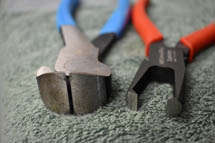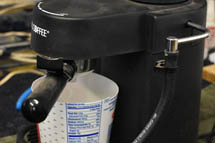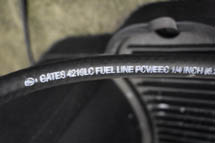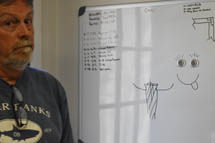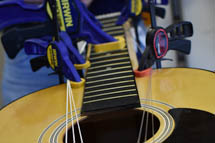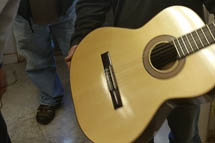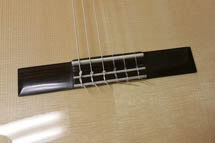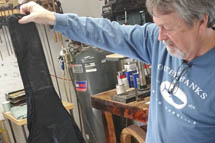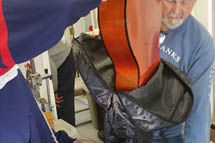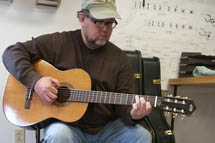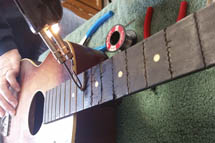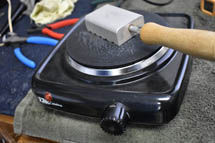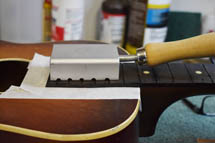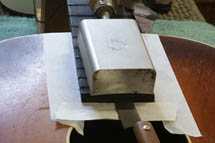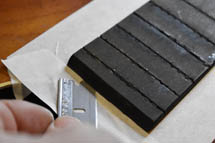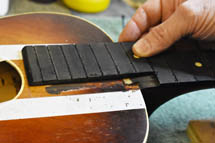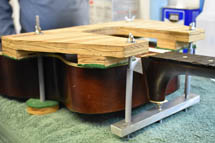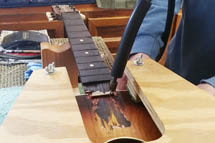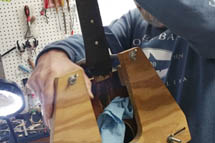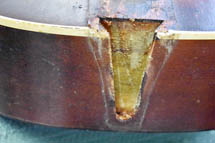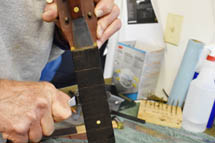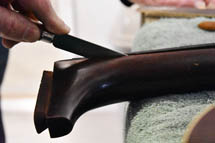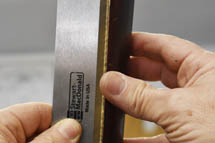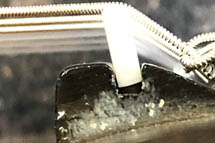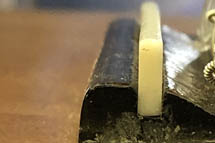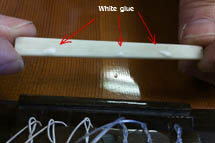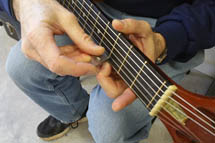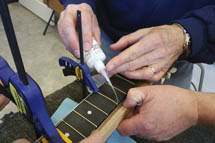Repair Workshop
Feb 29, 2020
Attendees:
- Chet Dickerson
- Howard Wilson
- Jack Gellerstedt
- Steve Clark
- Kenny Craft
- Larry Sakayama
- Dennis McKim
- Tom Pafford
- Gary Mellas
- Tim Runion
Click on any image to start the slide show.
Tip from Chet:
He repairs fingernail gouges in heavily worn fretboards by filling the depressions with CA glue (sometimes mixed with dust from the fingerboard for better color match). Prior to application of the CA glue he uses a razor to cut grooves (in the direction of the grain) in the gouged area to provide improved anchor surface for the glue. After the glue dries it is scraped with a blade and sanded flush.

Chet's shop in Roanoke, VA
(Notes: Jack Gellerstedt. Photos: Howard Wilson, Chet Dickerson, Larry Sakayama)
We worked on three guitars - the Truetone nylon string, the Silvertone steel string, and the Harmony. See the Jan. 18 notes for description of starting condition of all guitars.

Silvertone Guitar
Fret removal
Here's what it looked like after the last meeting.
At this meeting the rest of the frets were removed. Chet wetted the fingerboard for a day or so in advance to help make the wood less brittle. Just prior to removal the area around the fret was again wetted with water, then a soldering gun was used to heat the fret to the point the water that was pooled around it bubbled and steamed.
The removal tool is used by starting at one end of the fret and gradually working the end up. Stewart McDonald fret pullers (brought by Howard), were preferred by most of the participants over the flat-face ground conventional nippers (See tools note in left column). Then you continue across the fret loosening it a little at a time all along. Rocking the tool back and forth (in the longitudinal direction along the fingerboard) while gripping the fret helps the process.
Everyone had the opportunity to practice fret removal. As it turned out the finger board was so brittle it was not worthwhile to salvage it.
Fretboard removal
Next the fingerboard was loosened from the body of the guitar by heating it and working a razor blade and pallet knife under it. This proved to be easy but the brittle fingerboard cracked apart at around the 12th fret - thus, another reason to replace it.
With the fingerboard broken away the top of the dovetail joint was readily visible.
We used a Mr. Coffee machine as a steam generator to pump steam into the dovetail joint to loosen the glue. Chet's neck removal jig and some muscle were used to free the neck from the body.
Next, the rest of the fingerboard was removed. Heat was applied briefly but it was not difficult to work a pallet knife between the fingerboard and the neck, making the fingerboard easy to remove.
As was already known the neck is bowed upward too much thus creating an excessive relief (about .015”). The neck face was flattened with a few careful passes on the jointer. It is now ready for installation of a new fingerboard.

The Truetone Classical Guitar saddle repair
After sitting under tension for two weeks, the saddle was leaning forward and not properly seated in the slot (views from both sides below).
The saddle was removed and the groove was improved by squaring up the bottom. A simple tool was made by gluing a strip of sandpaper to a steel ruler. This was then used to square up the bottom sides of the groove. The top of the tool was tilted slightly away from the groove while cleaning the bottom corners. A slight bevel was made on each of the bottom edges of the saddle and this further helped the process of seating it firmly and all the way to the bottom of the groove.
Finally, three drops of white glue were used to secure the saddle in place and the squeeze-out cleaned up.


